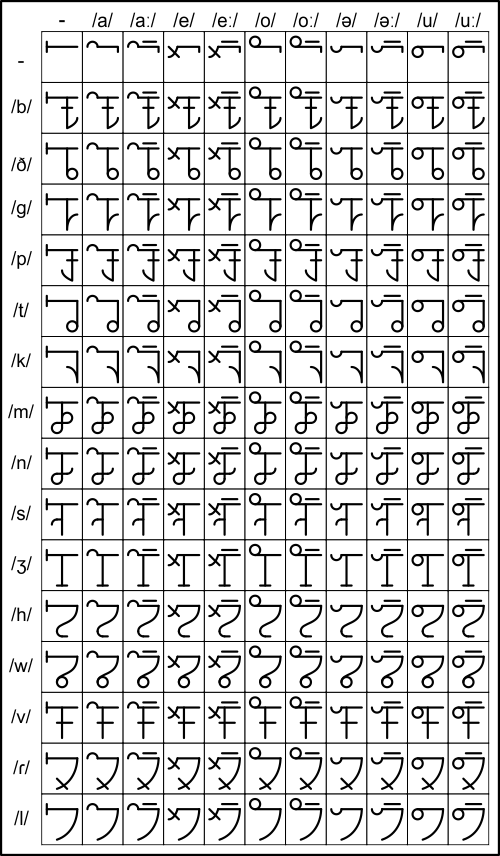Wadoona (waðuna)
Writing System
Wadoona's script, called Juh'howe, uses an abugida with limited featural elements. Words are meant to be spelled phonetically. Glyphs indicate the consonant in a given syllable. The top left portion of the bar above each consonant character indicates which vowel should follow the consonant. In cases where the bar is absent or a specific 'null' bar (leftmost column on the accompanying chart) is used, the vowel is omitted entirely. In contrast, the bar appearing by itself with a vestigial downward stroke on the right indicated that the consonant is to be omitted instead. A short bar over the top bar's right half indicates that the vowel is meant to be geminated.
The Juh'howe script is read from right to left and from top to bottom. Individual words are isolated from one another by empty spaces. A null bar followed by an empty space, indicates the end of the preceeding sentence. 'Cursive' Juh'howe may use a null bar instead of a space between words, allowing all characters to be strung together on a single topline. In this case, a null bar with an extra bar over it - coding for a 'gemination' of silence - is instead used to terminate a sentence. Cursive Juh'howe often features decorative calligraphy at either end of a given line or uses the unifying topline to 'guide' the words around in a decorative manner (i.e. when used as a border for an official-looking seal).
Morphology
Syntax
Gender
Wadoona features an obligatory grammatical gender structure that takes into account the physical gender (male/female/neutral), reality (real/conceptual) and, unusually, the time of origin (past/present/future) of a noun. A suffix is attached to a subject or object based on how it falls within these criteria, along with any articles associated with that noun (though not adjectives or adverbs).- Speakers generally default to their own gender or take a guess when presented with a non-object living being for which they cannot determine a gender; observant listeners can often infer a Wadoona speaker's own gender by the ratio of genders used in their speech patterns.
- For the purpose of grammatical gender, reality refers to the property of a noun being either 'real' (i.e. a material object or creature existing in the teporal world) or 'conceptual' (i.e. an object or creature that exists as a dream, hypothetical entity, quality, philosophy, or spiritual entity). Using the real gender on something that is otherwise a concept indicates that that concept has somehow been made manifest in the physical worlds (i.e. the implementation of a named organizational policy).
- For the purpose of grammatical gender, time of origin refers to the property of a noun being something of a previous cycle (the past, i.e. the ancient Curved Time, before the birth of the speaker, or roots in tradition or routine), the current cycle (the present, i.e. a resident of known history or one which/who is centered in the present day), or a coming cycle (the future, i.e. The Curved Time to come or the distant, unknowable, or hypothetical future). The present time of origin is most commonly used in everyday speech or when one is uncertain about the source of the person, place, or thing being discussed.
Vocabulary
Colors
Wadoona features a complex color naming system which uses agglutination to specify narrow categories of colors. Color descriptions typically take the form of "(hue 1)(hue 2)-(monochrome 1)(monochrome 2)," where the hues are one of eight fully-saturated colors and the monochromes are white, gray, or black. Hues 1 and 2 are mentally 'blended' by the speaker to create shades somewhere in between, with even 'impossible' color combinations (i.e. purple and yellow) being permissible. Speakers treat this blending as being like the mixing of paints rather than light, though Wadoona is somewhat unique in that shades which extend slightly into the infrared and ultraviolet also have terms. Similarly, monochrome 1 and 2 may be "white," "gray," or "black," with the combined terms expressing some shade between the two terms, again using the logic of blending paints. Any unnessary terms may be dropped; for example a red color which is no lighter, darker, or different in hue from the usual may simply be phrased as "red" with no further agglutination required. Finally, when the hue and monochrome terms are used in succession by the speaker - in order of greatest to least contribution to the final color - they are blended in the mind of the listener to indicate a very specific color. In addition to the color terms themselves, Wadoona features a wider selection of semantic primes relating to how a given color is applied to a scene than most natural languages in the Manifold. For example, instead of describing a physical image as merely a photo, painting, or sketch, Wadoona speakers may also make refference to the specific technique used (i.e. brushing, sponging, watercoloring, etc.) or material used (i.e. canvas, silkscreen, or photographic plate).Shapes
Like with colors, Wadoona has a unique agglutinative system for discussing the shapes found in a piece of visual art. The names of shapes take the form of "(number)(edge type)(concavity)." Number refers to the number of sides a noun in question appears to have. Theoretically, this can be any number, though in practice, only values up to six are used, with more complex shapes using the root for "many" instead. Edge type can be sharp, smooth, or beveled, with more than one term agglutinated to imply a blend between types (i.e. "bevelsmooth" would refer to beveled corners which terminate in rounded angles). Similarly, concavity can be convex or concave. When used as a noun, a shape word with a conceptual gender may indicate that a given shape is abstract or irregular rather than regular or well-defined.Relationships
Wadoona features a large lexicon of terms relating to interpersonal relationships. For example, instead of a single term for "love," Wadoona has terms which specifically refer to the love found between:- Oneself and one's romantic partner,
- Oneself and one's parents or offspring,
- Oneself and other non-parental relatives,
- Oneself and one's friends or pets,
- Oneself and other human beings,
- Oneself and the objects, activities, and aesthetics one enjoys,
- Oneself and one's god or gods,
- Oneself and one's nation or culture, and
- Oneself and nature.
Foreign Concepts
Wadoonists tend to eschew loan words, as Juh'howe (see Alphabet) lacks an effective mechanism to emulate unfamiliar sounds. Instead, neologisms are created from similar roots or, more often, the language is used to describe the desired concept in poetic or prosaic terms. The latter form of exposition is embraced by speakers because it adheres to one of the central conceits of the movement: the language is spoken by those who wish to observe the familiar from an unfamiliar distance in an attempt to divine its essential nature, stripped bare of cultural presuppositions.Phonetics
Vowels: /u/ (u), /e/, /o/, /ə/ (uh), /a/
Gemination is indicated by a hyphen following the vowel to be extended. Whenever /u/ or /o/ are repeated, silent apostrophes may be added to the gloss to denote the division between the vowels. For example, the word pronounced /tuoːno/ might be romanized as "tu'o-no." In practice, however, /u/ and /o/ are seldom found next to each other; speakers often add a /w/ sound between /u/ and /o/ sounds - or as an infix whenever any /u/ or /o/ are geminated - as a verbal flourish.





Comments